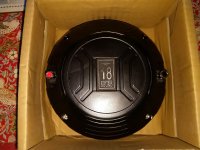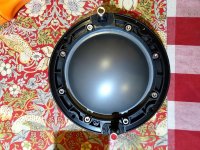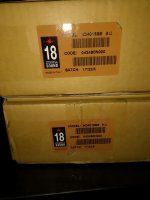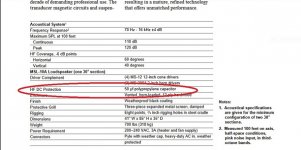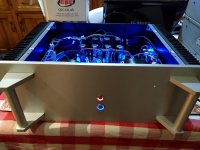A couple of weeks ago I go a good deal on some 18Sound ND4015be 1.5" throat 4" Beryllium diaphragm compression drivers and now have them installed in some JBL 2384 horns driven by Aleph J in a Bi-Amp active setup. Beautiful sound! BUT, Aleph J has a noticeable switch off thump and although I have a mute switch on the amp when I power it down I am concerned that a power outage or an error could send this thump to my Be diaphragms 😱
So I guess a protection capacitor is needed? Crossover is 630Hz so if I go an octave below that I'm going to need quite a large capacitor!
Any suggestions as to a good cap for this job? They sound so good I don't really want a capacitor in the signal path to affect anything 😀
So I guess a protection capacitor is needed? Crossover is 630Hz so if I go an octave below that I'm going to need quite a large capacitor!
Any suggestions as to a good cap for this job? They sound so good I don't really want a capacitor in the signal path to affect anything 😀
Why go an octave below. Put it right in the crossover region. Do your crossover measurements with the cap in place.
Thanks for the reply, I am already using steep Butterworth active slope crossover so I didn't want the cap to add to this and reduce level at the crossover point as then I would be 6dB down instead of 3dB. (Horn is rolling off slightly by 630Hz already)
Are you aware you *already* have various caps in series with your signal path?They sound so good I don't really want a capacitor in the signal path to affect anything
Be they large in series with the voice coil as the new protective one will or smaller in series with resistors inside active crossovers, *all* do what capacitors do, including shifting phase and other "horrors" attributed to dreaded "caps".
And you WANT, capacitors in the signal path AFFECTING sound, that´s what crossovers do.
The "purist" alternative is to feed drivers full range signal, from DC coupled preamps and power amps.
Back to your problem:
YES, add a protective cap, it´s a good idea.
You may either add the proper value one so it is an extra and useful component of the whole crossover system, just do the Math and remember you are increasing crossover order by one, you may choose to modify the active part accordingly, or make it significantly larger (2X, 4X, 10X , you decide) so it´s relatively "transparent" and can be ignored.
Your choice.
Is it DSP processing? if so then limit with a fast attack time IMO.in a Bi-Amp active setup
^Even with a limiter it won't solve the amplifier power off thump.
I would do what AllenB and JMfahey explained: put a cap at xover freq and include it in your overall xover design.
I would do what AllenB and JMfahey explained: put a cap at xover freq and include it in your overall xover design.
Thanks guys. I have an all digital signal path until the DAC so not many capacitors in the signal chain I would say..
It is only the amp switch off that concerns me, I can pull power to everything else and barely hear anything. DSP has limiters but won't help with this..
I am maybe worrying about nothing but I'm quite sure pulling power to the amps may damage the drivers. Maybe I'll include a cap at crossover as suggested and start again with crossover design. Easy enough with DSP! It would still be a fairly large cap though. Anyone have any favourites to recommend?
It is only the amp switch off that concerns me, I can pull power to everything else and barely hear anything. DSP has limiters but won't help with this..
I am maybe worrying about nothing but I'm quite sure pulling power to the amps may damage the drivers. Maybe I'll include a cap at crossover as suggested and start again with crossover design. Easy enough with DSP! It would still be a fairly large cap though. Anyone have any favourites to recommend?
For my AMT-1s I ordered some large motor starter capacitors. You can easily get as large as 100 uF, but they are really huge.
I was actually wondering the same thing, my JBL 2446’s are beefy as hell but the Bryston 4B I have to power them has a pretty intense thump when it powers on. Going to be doing active crossover but was worried a cap would affect those numbers. Or do you just hook it up with the cap and then measure and set the active after the fact?
Something to note: adding a cap doesn't simply add a first-order filter because the driver's impedance is non-linear.
I'd modify the amplifier to include a relay on the output.
Chris
I'd modify the amplifier to include a relay on the output.
Chris
Fact is you do 😎Thanks guys. I have an all digital signal path until the DAC so not many capacitors in the signal chain I would say..
DSP is a digital way of *emulating* what a physical crossover does, Math comes from decades old Physics and Math, only done by software and processing, so be certain it IS emulating what capacitors do.
In fact it´s emulating ALL components in a passive crossover to get same frequency response (which is what you want it to do), including inductors, attenuators, etc., so you´ll "have as many (virtual) capacitors in the path as the design calls for"
Only special advantage is that you can simulate "perfect" components, such as zero ESR capacitors, zero resistance inductors, etc.
But slope,phase shift, etc. , will be same as in the original crossover you are emulating/simulating.
So what?Adding a cap will significantly degrade your amp damping factor.
Drivers in principle expect some kind of crossover and are designed with that in mind.
Just imagine a third order (passive) crossover and what all those components do to amp damping 😱
So if a driver is competently designed, it will stand anything between amp and voice coil, including attenuating resistors, very common in crossovers, and a humble cap must be well within acceptable prameters.
Not really. A capacitor (we are talking a protection cap here, so this is a passive solution) changes the impedance what the amp sees and a DSP solution is not.DSP is a digital way of *emulating* what a physical crossover does, Math comes from decades old Physics and Math, only done by software and processing, so be certain it IS emulating what capacitors do.
Anyway, if someone don't hear a capacitor's own presence (other than the function of course) added to the signal path after the amp output, then it's good to him.
Last edited:
Maybe you could make a simple additional switch/relay that would work like speaker A/B selector in many commercial amplifiers , and turn it off first before amp.
This is what I do now! I have SSR speaker protection boards which deal with switch on thump by means of a three second delay at switch on. Unfortunately they are not quick enough to catch the switch off thump so I installed a mute switch which basically turns the SSR boards off. This works fine so long as you remember to press mute before you switch off!Maybe you could make a simple additional switch/relay that would work like speaker A/B selector in many commercial amplifiers , and turn it off first before amp.
I am only really concerned about a power outage or a breaker tripping as you wouldn't get to your mute button fast enough!
I've built dozens of actively driven speakers with compression drivers over the years and have never installed a protection cap and never had a problem. TBH most compression driver diaphragms are not massively expensive to replace but in this case the diaphragms would cost me more than I paid for the drivers and are quite difficult to get hold of!!
- Home
- Loudspeakers
- Multi-Way
- Protection cap for my precious new compression drivers?
